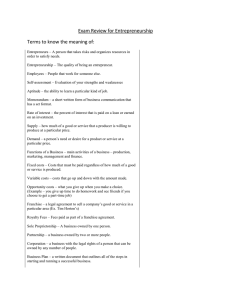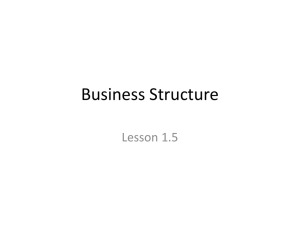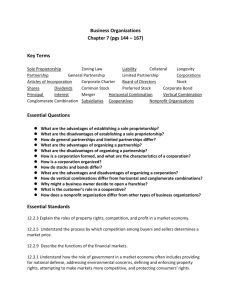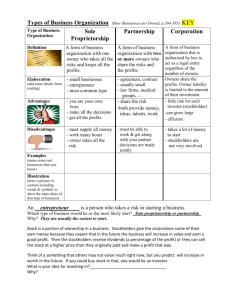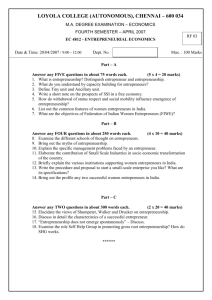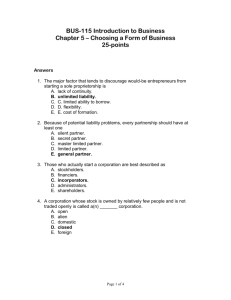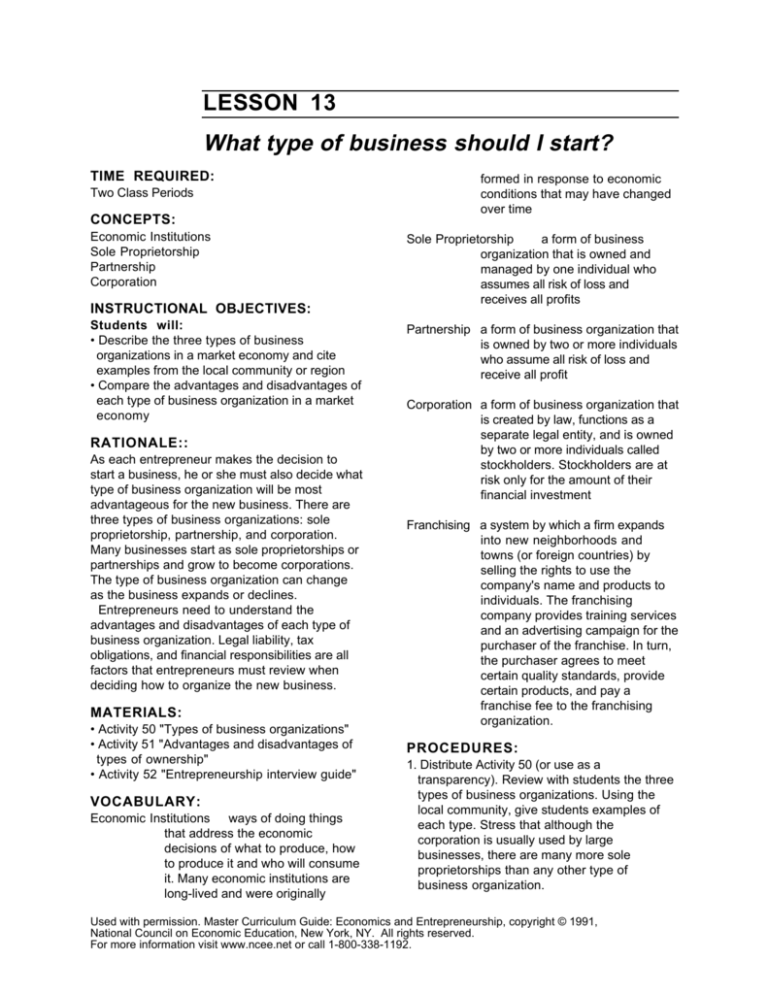
LESSON 13
What type of business should I start?
TIME REQUIRED:
Two Class Periods
CONCEPTS:
Economic Institutions
Sole Proprietorship
Partnership
Corporation
INSTRUCTIONAL OBJECTIVES:
Students will:
• Describe the three types of business
organizations in a market economy and cite
examples from the local community or region
• Compare the advantages and disadvantages of
each type of business organization in a market
economy
RATIONALE::
As each entrepreneur makes the decision to
start a business, he or she must also decide what
type of business organization will be most
advantageous for the new business. There are
three types of business organizations: sole
proprietorship, partnership, and corporation.
Many businesses start as sole proprietorships or
partnerships and grow to become corporations.
The type of business organization can change
as the business expands or declines.
Entrepreneurs need to understand the
advantages and disadvantages of each type of
business organization. Legal liability, tax
obligations, and financial responsibilities are all
factors that entrepreneurs must review when
deciding how to organize the new business.
MATERIALS:
• Activity 50 "Types of business organizations"
• Activity 51 "Advantages and disadvantages of
types of ownership"
• Activity 52 "Entrepreneurship interview guide"
VOCABULARY:
Economic Institutions ways of doing things
that address the economic
decisions of what to produce, how
to produce it and who will consume
it. Many economic institutions are
long-lived and were originally
formed in response to economic
conditions that may have changed
over time
Sole Proprietorship
a form of business
organization that is owned and
managed by one individual who
assumes all risk of loss and
receives all profits
Partnership a form of business organization that
is owned by two or more individuals
who assume all risk of loss and
receive all profit
Corporation a form of business organization that
is created by law, functions as a
separate legal entity, and is owned
by two or more individuals called
stockholders. Stockholders are at
risk only for the amount of their
financial investment
Franchising a system by which a firm expands
into new neighborhoods and
towns (or foreign countries) by
selling the rights to use the
company's name and products to
individuals. The franchising
company provides training services
and an advertising campaign for the
purchaser of the franchise. In turn,
the purchaser agrees to meet
certain quality standards, provide
certain products, and pay a
franchise fee to the franchising
organization.
PROCEDURES:
1. Distribute Activity 50 (or use as a
transparency). Review with students the three
types of business organizations. Using the
local community, give students examples of
each type. Stress that although the
corporation is usually used by large
businesses, there are many more sole
proprietorships than any other type of
business organization.
Used with permission. Master Curriculum Guide: Economics and Entrepreneurship, copyright © 1991,
National Council on Economic Education, New York, NY. All rights reserved.
For more information visit www.ncee.net or call 1-800-338-1192.
2. Distribute Activity 51. Review the information
on the activity sheet with the students.
Emphasize the legal liability, the tax
obligations, and financial responsibilities for
the business owner of each type of business
organization.
3. Divide the class into groups. Ask each group
to compile a list of questions it would like to ask
an entrepreneur about his or her business.
4. Ask the groups to share their lists. Write the
questions on the blackboard.
5. Distribute Activity 52 or project as a
transparency and have students write the
guidelines in their notebooks.
6. Invite several entrepreneurs to the next class.
Using Activity 52 and the students' compilation
of questions, have students interview the
entrepreneurs. Students can tape these
interviews with both audio and video
recorders. Try to include entrepreneurs
representing different types of business
organizations in the group.
EVALUATION:
Organize the class in small groups. Using Activity
52 as a guide, have the groups identify and
develop profiles of businesses in the local
community that are representative of each of the
three types of business organizations presented
in Activity 50.
Used with permission. Master Curriculum Guide: Economics and Entrepreneurship, copyright © 1991,
National Council on Economic Education, New York, NY. All rights reserved.
For more information visit www.ncee.net or call 1-800-338-1192.
ACTIVITY 50
Types of business organizations
Sole proprietorship
A form of business organization that is owned
and managed by one individual who assumes
all risk of loss and receives all profits.
Partnership
A form of business organization that is owned
by two or more individuals who assume all risk
of loss and receive all profit.
Corporation
A form of business organization that is created
by law, functions as a separate legal entity,
and is owned by two or more individuals called
stockholders. Stockholders are at risk only for
the amount of their financial investment.
Used with permission. Master Curriculum Guide: Economics and Entrepreneurship, copyright © 1991,
National Council on Economic Education, New York, NY. All rights reserved.
For more information visit www.ncee.net or call 1-800-338-1192.
ACTIVITY 51
Advantages and disadvantages of types of
ownership
Forms of ownership
Sole proprietorship
Advantages
Disadvantages
1. Low start-up costs
1. Unlimited liability
2. Greatest freedom
2. Lack of continuity
3. All profits to owner
3. Difficulty in raising capital
4. Owner in direct control
Partnership
1. Easy to form
1. Unlimited liability
2. Low start-up costs
2. Lack of continuity
3. Divided authority
3. Divided authority
4. Difficulty in finding suitable partner
Corporation
Franchise
1. Limited liability
1. Close regulation
2. Specialized management
2. Most expensive to organize
3. Ease of raising capital
3. Extensive record-keeping
1. Smaller than usual capital investment
1. Possible high franchiser fee
2. Prior public acceptance of product
2. Some loss of independence
3. Better than average profit margins
3. Possible difficulties in canceling contract
4. Management assistance
Used with permission. Master Curriculum Guide: Economics and Entrepreneurship, copyright © 1991,
National Council on Economic Education, New York, NY. All rights reserved.
For more information visit www.ncee.net or call 1-800-338-1192.
ACTIVITY 52
Entrepreneurship interview guide
1. Name of entrepreneur
2. Name of entrepreneur's business
3. Type of business organization
4. List products of business (goods and/or services)
5. Number of employees
6. List benefits of business to society
7. Chart growth of business since its inception
8. Challenges in operating the business
Used with permission. Master Curriculum Guide: Economics and Entrepreneurship, copyright © 1991,
National Council on Economic Education, New York, NY. All rights reserved.
For more information visit www.ncee.net or call 1-800-338-1192.

